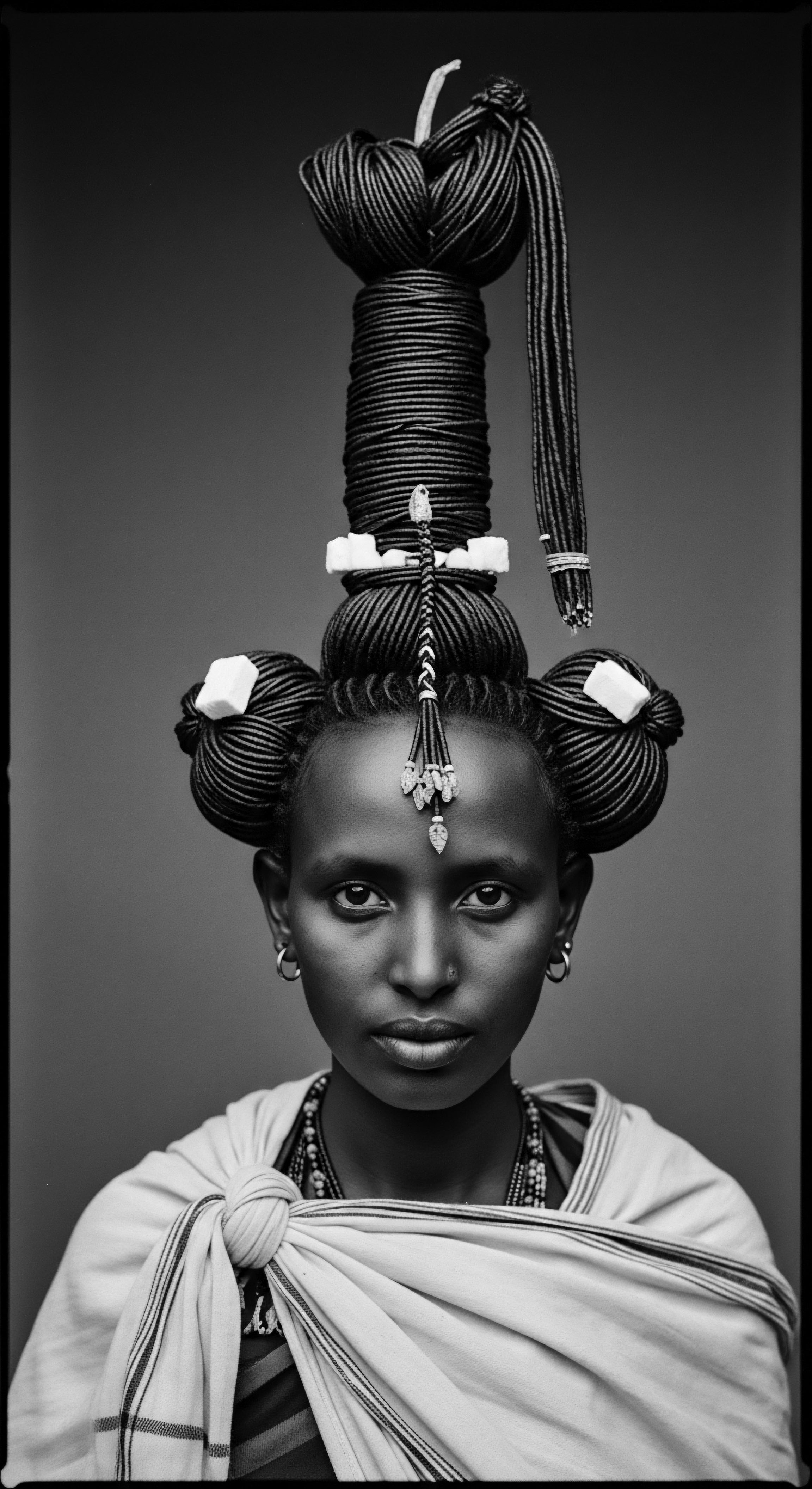
Fundamentals
The very notion of Sunlight Exposure Heritage stands as a quiet testimony to generations past, a living archive inscribed within the curl and coil of textured hair. At its simplest, this idea speaks to the deeply ingrained wisdom, passed through time, concerning the ways in which communities with textured hair—particularly those of African and mixed-race lineage—have perceived, adapted to, and cared for their hair in the presence of the sun’s pervasive glow. It is a remembrance of ancestral understanding, a recognition of how sunlight shaped not only the environment but also the practices and products used to nurture hair.
Consider the elemental truth ❉ sunlight is a force of creation and transformation. For centuries, our forebears lived in profound communion with the rhythms of the natural world, where the sun’s daily journey across the sky marked the passage of time and dictated agricultural cycles, daily routines, and, indeed, personal care rituals. For those whose ancestry lies in sun-drenched lands, the interactions between solar energy and hair were an undeniable reality.
This reality led to observation, experimentation, and the gradual accumulation of knowledge about how hair responded to light, heat, and the very air around it. The Meaning of Sunlight Exposure Heritage, in its foundational sense, is thus the collective ancestral intelligence that informed hair practices designed to maintain health and vitality under continuous solar influence.
Sunlight Exposure Heritage denotes the generational wisdom, practical knowledge, and adaptive customs born from the intimate relationship between textured hair and solar presence across ancestral timelines.
These rudimentary practices often sprang directly from the earth itself. People learned which plant oils offered a certain sheen and protection, which leaves could soothe a sun-scorched scalp, or which styling methods could shield delicate strands from harsh rays. This understanding was not theoretical; it was lived, practiced, and transmitted from elder to child, woven into the very fabric of daily life.
The Sunlight Exposure Heritage, at its most fundamental, represents this interwoven relationship—a continuous dialogue between human ingenuity and environmental conditions, all centered on the enduring resilience and beauty of textured hair. It is a testament to the intuitive understanding of nature’s provisions, a legacy that still resonates in many contemporary hair care approaches.
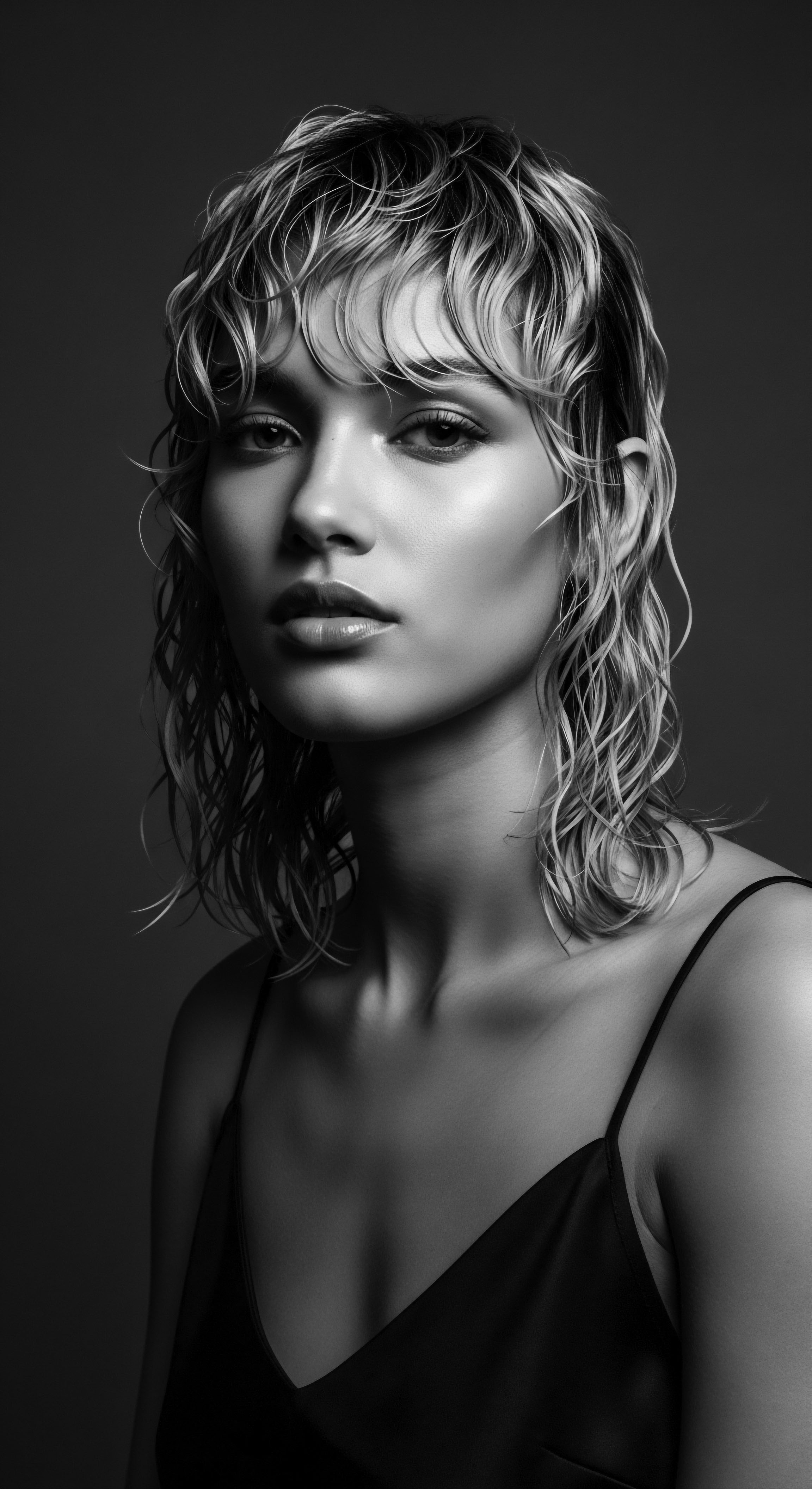
Echoes from the Source ❉ Early Adaptive Customs
The earliest iterations of Sunlight Exposure Heritage are found in the ingenious adaptive customs developed in regions where intense solar radiation was a constant companion. Communities in various parts of Africa, for instance, learned to honor the sun while also safeguarding their hair’s integrity. These early strategies were not complex, but they were remarkably effective, drawing directly from indigenous flora and fauna. The Explanation of these practices often lies in their direct functionality ❉ to moisturize, to protect from drying, or to mitigate the effects of environmental stressors.
- Plant Butters ❉ Shea butter, derived from the African shea tree, provided a rich emollient, forming a protective barrier against the sun’s drying action.
- Nut Oils ❉ Palm oil and coconut oil, both abundant in tropical regions, were utilized for their conditioning properties, helping to retain moisture in hair exposed to heat.
- Protective Styles ❉ Braids, twists, and elaborate updos, beyond their aesthetic or symbolic value, served a practical role in minimizing the surface area of hair exposed directly to sunlight.
- Natural Dyes ❉ Certain plant-based dyes, like henna, were used not only for color but also for their purported strengthening properties, which could enhance hair’s resilience.
The Description of these practices speaks to a profound ecological harmony, where human needs were met through observation and thoughtful utilization of natural resources. Each application, each style, carried with it generations of trial and refinement, a silent transmission of knowledge under the watchful sun. This early heritage, therefore, is not merely about surviving the sun; it is about thriving within its presence, about nurturing hair so that it might continue to serve as a crown, a symbol, and a shield.
| Region/Culture West Africa (e.g. Mali, Ghana) |
| Traditional Practice Use of Shea Butter (Karité) |
| Primary Sunlight-Related Benefit Moisture retention, physical barrier against UV, scalp conditioning. |
| Region/Culture Central Africa (e.g. Congo Basin) |
| Traditional Practice Elaborate Braiding Patterns |
| Primary Sunlight-Related Benefit Minimizes direct solar exposure, mechanical protection of strands. |
| Region/Culture Horn of Africa (e.g. Ethiopia) |
| Traditional Practice Application of Kera Oil (Castor Oil) |
| Primary Sunlight-Related Benefit Nourishment, sheen, thought to strengthen hair against breakage. |
| Region/Culture Southern Africa (e.g. Himba) |
| Traditional Practice Ochre and Butter Paste (Otjize) |
| Primary Sunlight-Related Benefit Sunscreen for hair and skin, prevents dryness, cultural significance. |
| Region/Culture These practices embody deep ancestral knowledge for safeguarding hair health under prevailing solar conditions. |
This initial phase of Sunlight Exposure Heritage underlines a direct, intuitive relationship with the environment. It is the beginning of a story, a foundational layer of understanding passed down through the very fibers of our communities and our textured strands. The consistent application of these natural principles fostered hair that endured, hair that reflected the vitality of its wearers despite environmental demands.

Intermediate
Moving beyond the foundational tenets, the Sunlight Exposure Heritage deepens into a more intricate interplay of traditional knowledge, communal practice, and the evolving identity of textured hair across the diaspora. The Meaning expands to encompass the cultural adaptation and preservation of hair wellness rituals, even as communities faced new geographical landscapes and social realities. It is a story not just of survival, but of resilience, of finding ways to maintain the inherent beauty and health of hair while navigating historical shifts.
The Explanation here delves into how ancestral practices, initially born of direct environmental necessity, transformed into cherished cultural traditions. These traditions carried forward the empirical knowledge of what nurtured hair under the sun, even when the sun’s intensity might have changed, or when new ingredients became accessible. The emphasis shifted from purely reactive protection to proactive care deeply embedded in daily life and community bonds.
The tender application of oil, the careful sectioning for protective styles, the shared moments of hair grooming—these were not merely tasks. They became rituals, each infused with generational narratives and the subtle wisdom of Sun-kissed hair experiences.
The intermediate understanding of Sunlight Exposure Heritage reveals how ancestral hair care, responsive to solar demands, became culturally embedded practices reflecting community bonds and adaptable resilience across varied geographies.
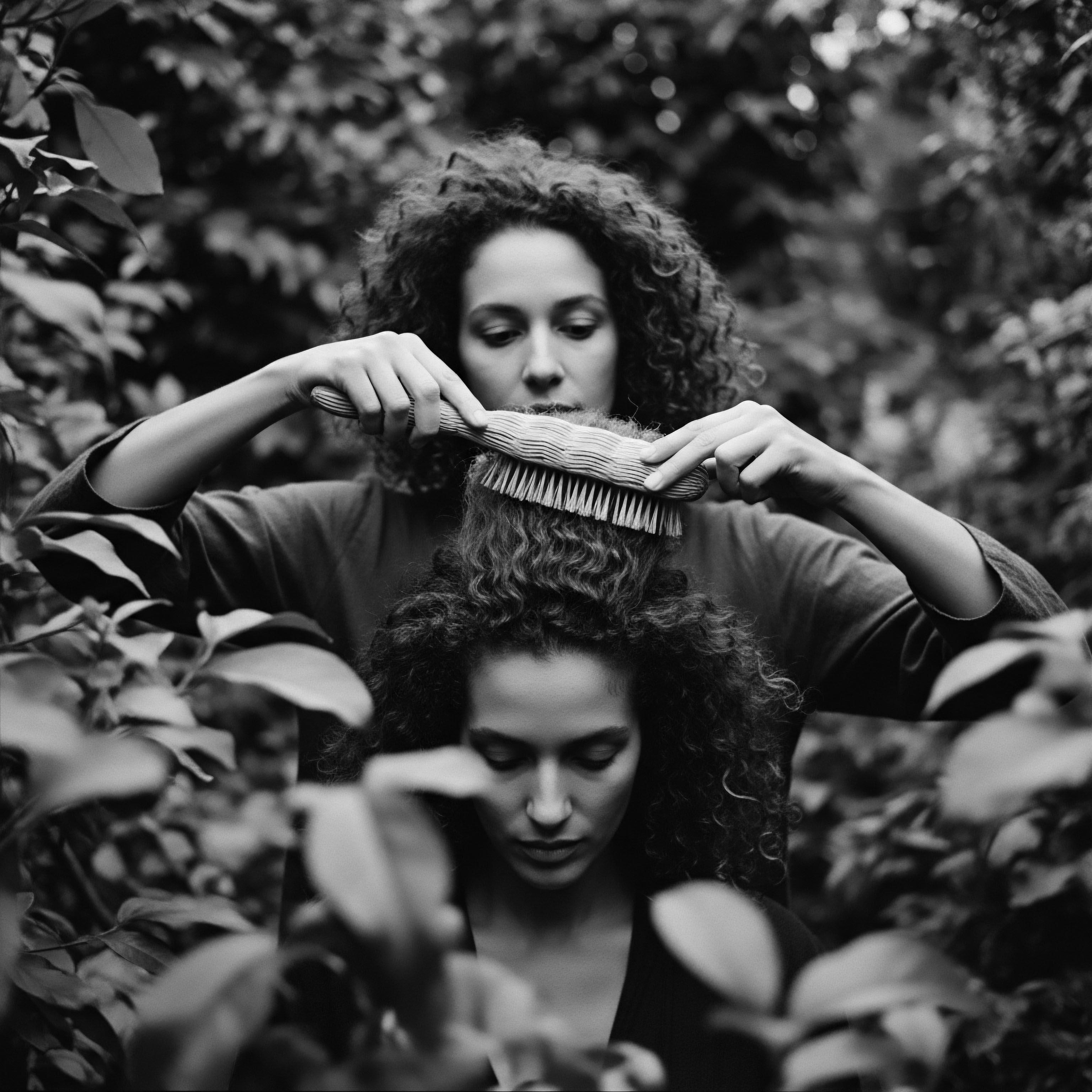
The Tender Thread ❉ Living Traditions of Care and Community
The Sunlight Exposure Heritage truly comes alive in the “Tender Thread” of living traditions. This refers to the continuous, often unspoken, transfer of hair care wisdom through familial lines and communal gatherings. It encompasses the intricate knowledge of how different hair types respond to solar exposure, the subtle signs of sun-induced dryness, and the nuanced application of remedies. This knowledge was communal property, shared freely amongst women, passed from grandmothers to mothers to daughters, often during long hours of styling.
In many diasporic communities, the sun remained a powerful presence, whether it was the intense heat of the Caribbean or the more temperate, yet still impactful, sun of North America or Europe. The ancestral memory of sun’s influence persisted. For instance, the practice of oiling the scalp and strands, a legacy of ancient African societies, continued to be a central act of care. The Description of these practices involves more than just the physical act; it includes the spiritual and communal dimensions.
Hair grooming sessions were often social events, where stories were exchanged, wisdom imparted, and communal identity affirmed. The sunlight outside often dictated the setting – perhaps under a shaded porch, or in a sunlit room, but the conversation invariably touched upon the elements, including the sun’s touch on the hair.
The types of oils and butters employed expanded as new indigenous resources became available in different lands, yet their fundamental purpose—protection and nourishment in the face of solar exposure—remained steadfast. The Clarification of this heritage reveals that flexibility was key. Communities did not rigidly adhere to ingredients if they were not locally available, but rather adapted the principles of care that had served them for centuries.
- Hot Oil Treatments ❉ Warming oils like olive, coconut, or castor oil before application, a practice found in many cultures, helped deeper penetration, offering enhanced conditioning against solar dryness.
- Water-Based Moisturizing ❉ The recognition of water as hair’s primary moisturizer, followed by sealing with oil, became a critical component, particularly in humid, sunny environments where evaporation was constant.
- Head Wraps & Scarves ❉ Beyond fashion or religious observance, head coverings served as a practical, culturally rich method of physical shielding from direct solar rays, preserving moisture and preventing damage.
- Clay Masks ❉ Certain traditions utilized natural clays, often mixed with herbs and oils, as scalp and hair treatments, which could offer mineral fortification and a protective layer against environmental exposure.
The Delineation of these intermediate practices also reveals how hair became a canvas for identity and expression, even as its protective aspects were quietly maintained. Styles like cornrows or elaborate twists, while beautiful, offered intrinsic sun protection by minimizing exposed surface area. The knowledge of how to cultivate hair that could withstand the sun’s pervasive gaze was not just practical; it was a deeply ingrained aspect of communal pride and self-sufficiency.
| Practice Category Oiling Rituals |
| Ancestral Origin (Echoes) Indigenous plant butters/oils |
| Diaspora Adaptation (Tender Thread) Incorporation of new local oils (e.g. olive, avocado in new regions) |
| Sunlight Connection Continuous moisture barrier, enhanced sheen under sun. |
| Practice Category Protective Styling |
| Ancestral Origin (Echoes) Complex African braiding/coiling |
| Diaspora Adaptation (Tender Thread) Development of specific styles like cane rows, twists, locs in new lands |
| Sunlight Connection Reduces hair surface area exposed to UV, maintains moisture. |
| Practice Category Head Coverings |
| Ancestral Origin (Echoes) Ancient veiling/headwraps for utility/symbolism |
| Diaspora Adaptation (Tender Thread) Cultural significance paired with practical sun shield |
| Sunlight Connection Physical barrier against direct solar radiation and heat. |
| Practice Category Diasporic communities sustained hair health by adapting ancestral wisdom to new environments, perpetually honoring hair's response to the sun. |
This intermediate stratum of the Sunlight Exposure Heritage illustrates a continuous conversation between inherited wisdom and environmental realities. It speaks to the enduring legacy of care, transmitted not only through words but through touch, observation, and the shared rhythm of hair grooming—a tender thread connecting past to present, all under the enduring presence of the sun. The significance of these traditions is magnified when we consider how they were preserved through profound social disruption, underscoring the vital role hair played in cultural continuity.
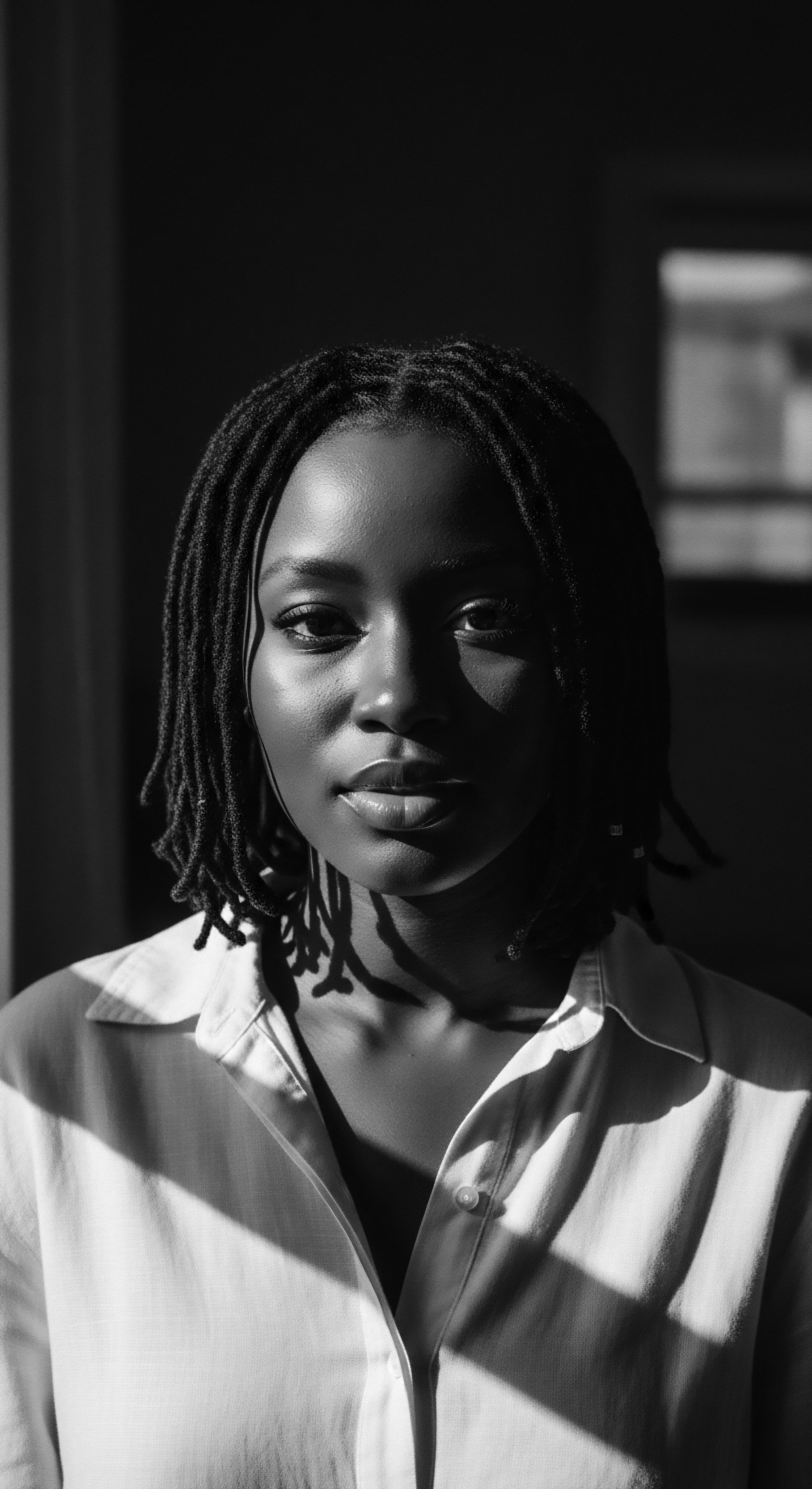
Academic
The academic understanding of Sunlight Exposure Heritage represents a sophisticated convergence of historical anthropology, material culture studies, and contemporary biophysical science. It is a comprehensive Definition that positions this heritage not merely as a collection of quaint customs, but as a robust, empirically grounded knowledge system developed over millennia by populations with textured hair. This deep dive requires an examination of the intricate molecular and structural responses of hair to solar radiation, juxtaposed against the complex socio-cultural adaptations articulated by Black and mixed-race communities. We are not simply observing practices; we are dissecting the ‘why’ and ‘how’ with rigorous academic inquiry.
This academic lens allows for a nuanced Explanation, recognizing that textured hair, due to its unique helical structure, varying curl patterns, and often elevated melanin content, interacts with solar radiation in specific ways. While melanin offers a degree of photoprotection to the hair shaft, prolonged exposure to ultraviolet (UV) radiation—specifically UVA and UVB—induces protein degradation, lipid peroxidation, and the formation of free radicals, leading to cuticle damage, reduced elasticity, color changes, and increased porosity. (Goyal & Singh, 2018). The historical ingenuity of ancestral hair care practices, therefore, can be viewed as an ancient form of dermatological science, predating modern photoprotective agents, yet achieving remarkable efficacy in mitigating these photo-induced insults.
From an academic perspective, Sunlight Exposure Heritage constitutes a resilient socio-bio-adaptive knowledge system, detailing how textured hair communities historically mitigated solar radiation’s impact through sophisticated, empirically validated care practices.

The Unbound Helix ❉ Biocultural Adaptation and Identity
The Meaning of Sunlight Exposure Heritage, at this scholarly level, transcends simple historical observation to encompass the biocultural co-evolution of hair and care practices. It is a testament to the adaptive genius embedded within cultural transmission. The methods of protection and nourishment were not random; they were meticulously refined over time, based on lived experience and observable outcomes.
The strategic application of specific botanical lipids, for instance, offered both a physical barrier against UV penetration and replenishment of the hair’s natural lipid layer, which is particularly vulnerable to depletion by solar exposure. The practice of regularly cleansing and conditioning, often with plant-derived saponins and emollients, served to remove environmental pollutants and restore moisture, counteracting the drying effects of the sun.
Consider the Specification of protective styling within the academic framework of Sunlight Exposure Heritage. Styles such as tightly woven braids, locs, or intricately sculpted cornrows are not merely aesthetic choices or cultural markers. From a biophysical standpoint, they minimize the hair’s surface area directly exposed to solar radiation, thereby reducing the cumulative dose of UV light received by individual strands. This reduction directly mitigates protein cross-linking and oxidative stress on the keratin structure.
For example, a historical account from the 17th-century Caribbean details enslaved African women creating elaborate head coverings, often layered with natural fabrics, and maintaining tightly coiled hairstyles. These practices, while outwardly expressions of defiance and cultural continuity, served a crucial protective function against the relentless tropical sun during arduous labor in fields. The deliberate manipulation of hair density and configuration, paired with the application of indigenous oils, demonstrates an implicit, inherited understanding of photoprotection and moisture retention under extreme solar conditions.
The Elucidation of this heritage reveals that the traditional use of natural oils and butters, such as shea (Vitellaria paradoxa), cocoa (Theobroma cacao), and coconut (Cocos nucifera) oils, was not merely anecdotal. These substances contain varying concentrations of fatty acids, antioxidants, and in some cases, natural UV filters, which scientific studies now validate for their potential to reduce photo-oxidative damage to hair fibers (Kim, 2011). The ancestral practices were, in essence, pragmatic applications of what modern science now characterizes as bioactive compounds and physical barriers.

Interconnected Incidences ❉ Global Diasporic Hair Ecology
The Sunlight Exposure Heritage also mandates an exploration of its interconnected incidences across diverse diasporic communities, revealing how core principles were adapted to varied ecologies and socio-political contexts. The cultural Designation of hair care as a communal, intergenerational activity served to reinforce the transmission of these vital practices. The act of communal hair grooming sessions, prevalent in many African and diasporic societies, was a pedagogical space where the younger generation learned not only the techniques but also the rationale behind them—the importance of moisture retention, the benefit of sun protection, the symbolism of healthy hair.
The Connotation of hair as a profound marker of identity—spiritual, social, and political—imbued its care with deeper significance. In contexts where identity was challenged or suppressed, the deliberate maintenance of hair health and traditional styles, even under the sun’s gaze, became an act of self-preservation and cultural affirmation. The resilience of these practices, defying forced assimilation and the harsh realities of displacement, underscores the inherent strength of the Sunlight Exposure Heritage. The sun, paradoxically, became a constant, unchanging witness to the enduring spirit of communities nurturing their strands and their legacy.
- Nutrient Replenishment ❉ Traditional deep conditioning methods, often involving fermented rice water or herbal infusions, provided amino acids and vitamins, strengthening hair against environmental stressors like solar radiation.
- Scalp Health ❉ Massaging the scalp with stimulating oils, a common ritual, promoted circulation and supported a healthy follicular environment, crucial for hair resilience when exposed to elements.
- Seasonal Adaptations ❉ Understanding the seasonal variations in solar intensity prompted different care routines, from heavier oiling in dry, sunny seasons to lighter, more frequent cleansing in humid periods.
- Generational Transfer ❉ The oral transmission of remedies and styling techniques, often accompanied by stories and songs, solidified the cultural memory of how to thrive with hair under the sun.
The academic Interpretation of Sunlight Exposure Heritage invites us to critically analyze the wisdom embedded in ancestral practices, not as relics, but as dynamic systems of knowledge that offer valuable insights for contemporary hair science. It moves beyond a romanticized view to a rigorous appreciation of how these communities, through keen observation and communal learning, developed effective solutions to a persistent environmental challenge. This is a powerful counter-narrative to Eurocentric beauty standards, affirming the inherent scientific and cultural validity of Black and mixed-race hair traditions.
| Traditional Practice Application of Shea Butter/Cocoa Butter |
| Biophysical Mechanism (Scientific Correlate) Forms occlusive lipid barrier; contains antioxidants (tocopherols, polyphenols). |
| Protective Efficacy Against Solar Exposure Reduces moisture loss (transepidermal water loss), physical UV attenuation, free radical scavenging. |
| Traditional Practice Intricate Braiding/Locing |
| Biophysical Mechanism (Scientific Correlate) Reduces exposed surface area; provides structural reinforcement. |
| Protective Efficacy Against Solar Exposure Lowers cumulative UV dose to individual hair strands; minimizes photo-oxidative damage to keratin. |
| Traditional Practice Use of Plant Extracts (e.g. Amla, Hibiscus) |
| Biophysical Mechanism (Scientific Correlate) Contains tannins, flavonoids, vitamins (e.g. Vitamin C). |
| Protective Efficacy Against Solar Exposure Antioxidant activity, potential for mild UV absorption, strengthening hair shaft. |
| Traditional Practice Regular Oiling/Greasing |
| Biophysical Mechanism (Scientific Correlate) Replenishes exogenous lipids; enhances hydrophobicity. |
| Protective Efficacy Against Solar Exposure Maintains hair elasticity, reduces protein loss, mitigates cuticle damage from drying. |
| Traditional Practice Ancestral practices frequently employed multi-modal protective strategies, underscoring a sophisticated, implicit understanding of hair photobiology. |
The academic investigation into Sunlight Exposure Heritage thus reveals a profound intersection of environmental adaptation, biological understanding, and cultural continuity. The hair, in its myriad textures and styles, stands as a living testament to this ancestral acumen, forever unbound yet deeply rooted in the stories of sunlight and resilience. This scholarly pursuit provides a framework for acknowledging the scientific validity inherent in traditional practices, elevating them from anecdotal to evidence-based cultural phenomena.
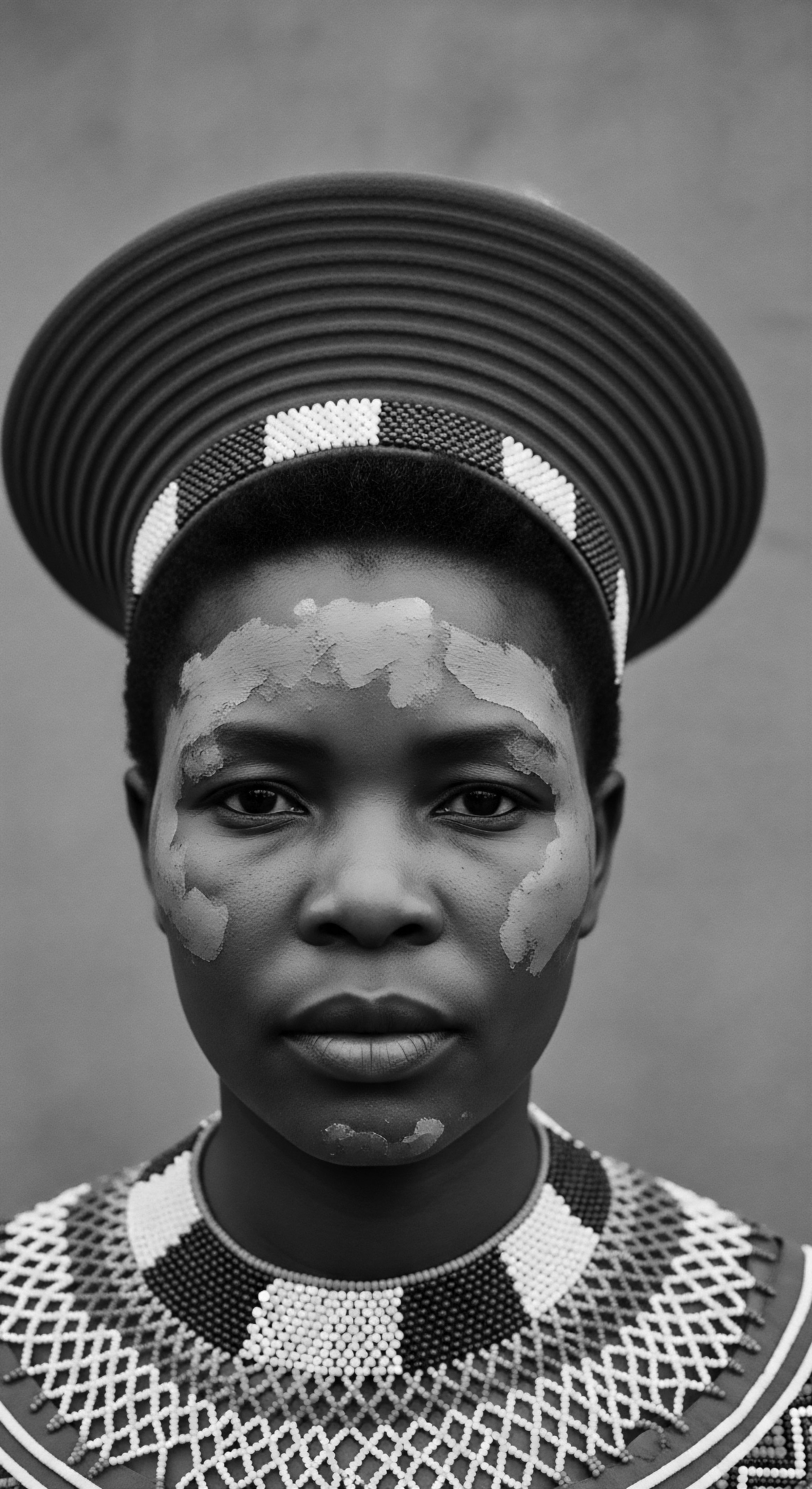
Reflection on the Heritage of Sunlight Exposure Heritage
To reflect upon the Sunlight Exposure Heritage is to embark on a contemplative journey, recognizing how profoundly the sun’s enduring presence has shaped the very soul of textured hair and its communities. This heritage is not a static concept, relegated to dusty history books. Instead, it pulses with a dynamic energy, a continuous dialogue between the ancient wisdom of our forebears and the evolving understanding of our present.
It underscores that hair, in its magnificent variations of curl and coil, has always been more than a physical adornment. It is a living chronicle, bearing the marks of sun-drenched resilience and the tender care bestowed upon it across countless generations.
The true Significance of this heritage lies in its profound capacity to connect us to a past brimming with ingenious solutions and deeply rooted self-sufficiency. It reminds us that knowledge about hair care, particularly concerning its interaction with the elements, was honed not in laboratories, but within the vibrant tapestry of daily life, through observation, communal practice, and intergenerational transfer. This understanding offers a powerful lens through which to appreciate the inherent strength and adaptability of textured hair, affirming its natural inclinations and challenging any narrow standards of beauty.
As we gaze towards the future, the Sunlight Exposure Heritage remains a guiding light. It encourages us to reconsider what “modern” care truly signifies, inviting us to draw inspiration from practices proven effective for centuries, often with sustainable, earth-derived ingredients. It prompts us to honor the narrative spun by each strand—a narrative of survival, beauty, and unwavering connection to a heritage that thrived under the open sky.
In every carefully chosen oil, every protective style, and every shared moment of grooming, we echo the wisdom of those who came before us, ensuring that the radiant legacy of hair under the sun continues to shine brightly. This continuous legacy underscores the ‘Soul of a Strand’ ethos, where each fiber carries the story of its deep ancestral journey, bathed in sunlight and nurtured by timeless hands.

References
- Goyal, A. & Singh, K. (2018). Hair and Scalp Disorders ❉ A Scientific Approach. CRC Press.
- Kim, H. J. (2011). Effect of UV radiation on human hair. Journal of Cosmetology, 20(3), 185-192.
- Ndikontar, R. K. (2010). Hair and Identity in African Societies. Africa World Press.
- Bender, C. (2015). Headwrap. Bloomsbury Academic.
- Dawson, H. (2014). African Hair. In The Oxford Handbook of African Archaeology. Oxford University Press.
- Byrd, A. D. & Tharps, L. D. (2001). Hair Story ❉ Untangling the Roots of Black Hair in America. St. Martin’s Press.
- White, S. (2019). The Power of the Headwrap. University of Pennsylvania Press.
